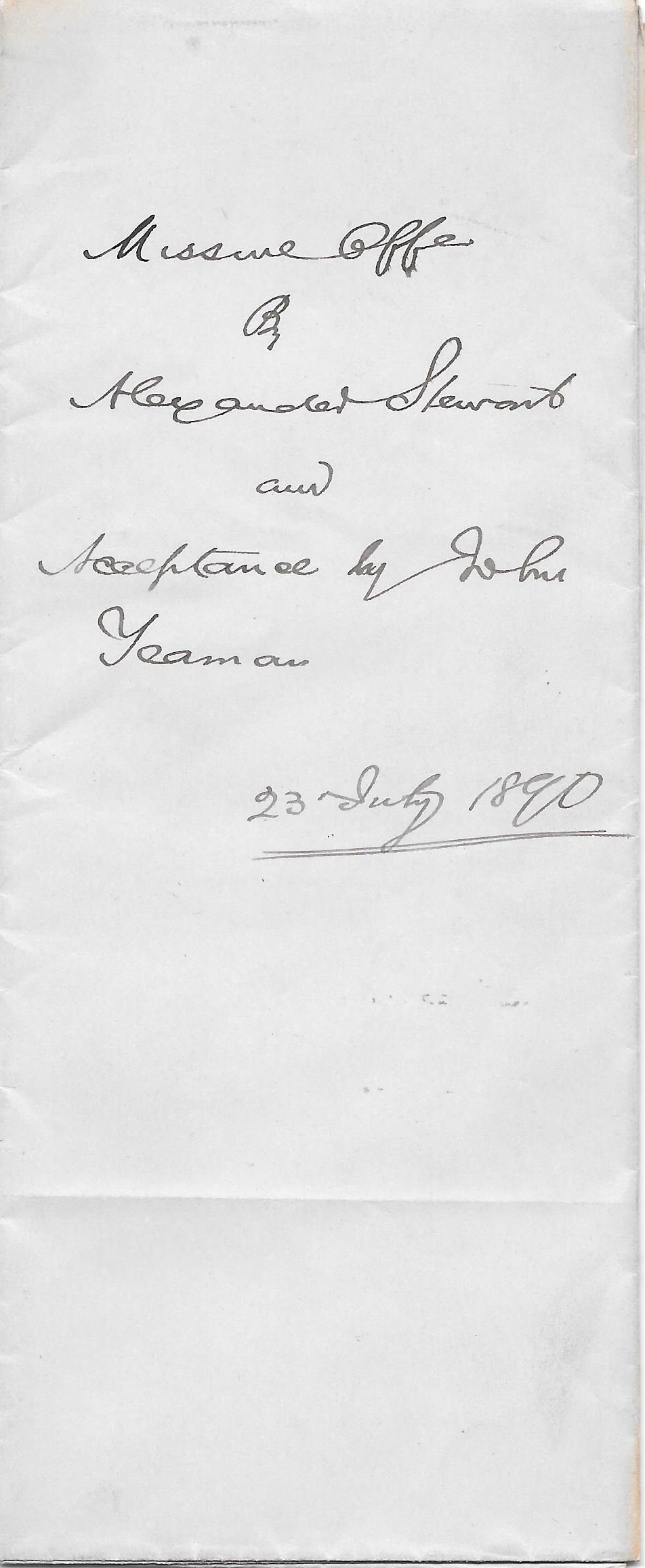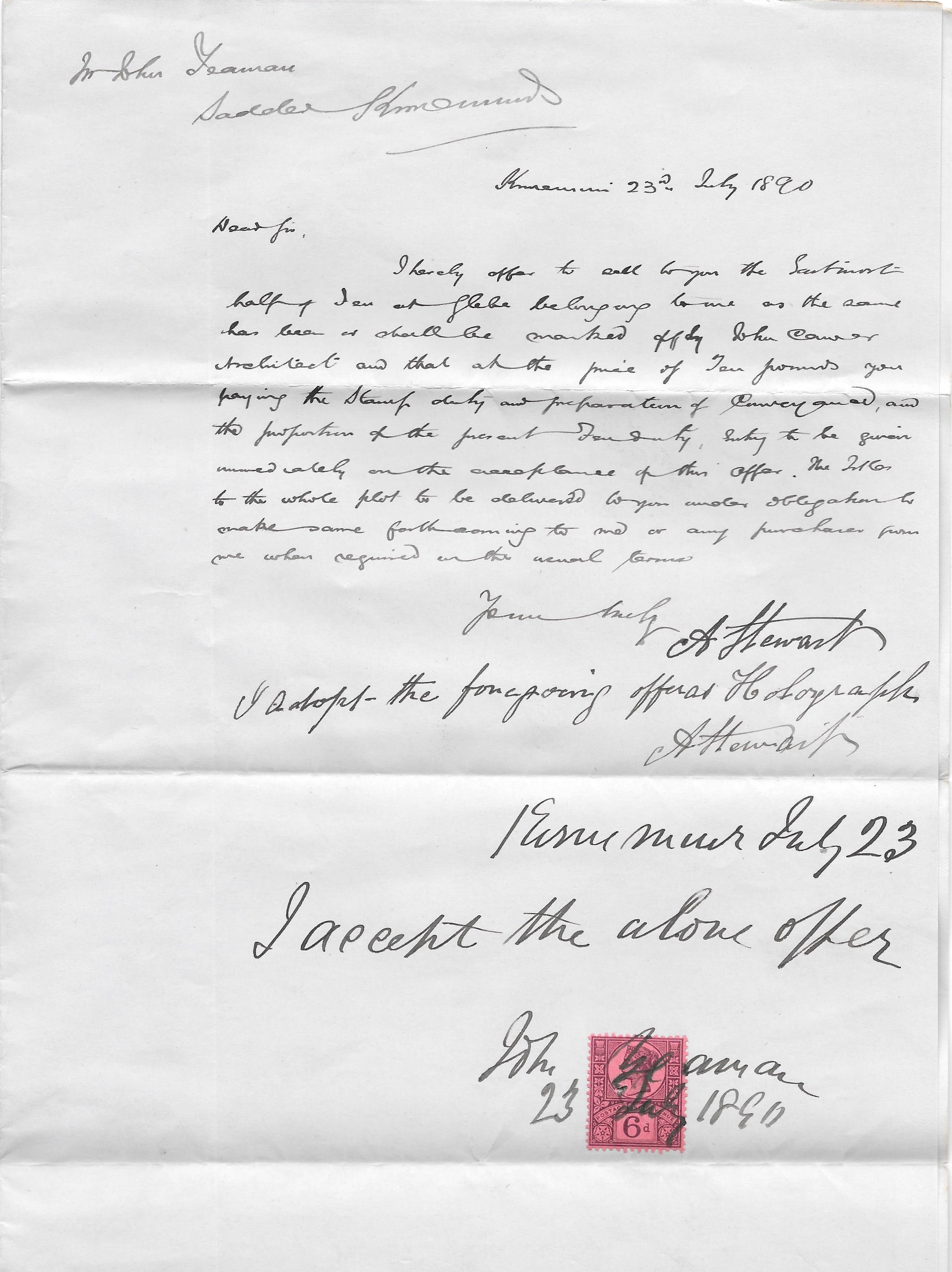A Window into Victorian Land Transactions: The 1890 Missive Offer between Alexander Stewart and John Yeaman
 The document presented—dated 23 July 1890 and exchanged between Alexander Stewart and John Yeaman—is a concise yet revealing example of late 19th-century Scottish conveyancing practice. It illustrates how legal agreements relating to land and property were conducted in an era when handwritten correspondence and personal negotiation formed the bedrock of commercial and private transactions. This essay explores the historical significance of such “missive offers,” the roles of the parties involved, and the broader social and economic context in which this transaction took place.
The document presented—dated 23 July 1890 and exchanged between Alexander Stewart and John Yeaman—is a concise yet revealing example of late 19th-century Scottish conveyancing practice. It illustrates how legal agreements relating to land and property were conducted in an era when handwritten correspondence and personal negotiation formed the bedrock of commercial and private transactions. This essay explores the historical significance of such “missive offers,” the roles of the parties involved, and the broader social and economic context in which this transaction took place.
What Is a “Missive Offer”?
In Scottish legal tradition, a “missive offer” refers to a formal written offer—usually relating to the sale or lease of property—which, once accepted, forms a binding contract. The process typically involves an exchange of letters (the “missives”) between the buyer and seller, often facilitated by solicitors. Unlike in England, where contracts for land require elaborate deeds and signatures before witnesses, Scots law recognises the validity of such correspondence as soon as the terms are agreed.
The key features of a missive offer are:
-
Clarity of terms: The offer must state what is being sold, for how much, and on what conditions.
-
Acceptance: The contract is only formed when the other party unequivocally accepts the terms in writing.
-
Binding nature: Once accepted, the agreement is enforceable in law, even if no formal deed has yet been drawn up.
Analysis of the Document
Parties Involved
-
Alexander Stewart: The seller, offering his interest (described as “Sentiment half of Sea at Glale belonging to me”) to John Yeaman.
-
John Yeaman: The purchaser, who accepts the offer under the stated conditions.
-
John Cameron, Solicitor: Named in the document as having marked out or valued the property, suggesting his role as a legal advisor or surveyor.
-
Isobel Simmonds: Named at the top, possibly as an interested party, witness, or another stakeholder in the transaction.
The Transaction
 Alexander Stewart offers to sell his “Sentiment half of Sea at Glale,” a phrase which, while archaic, likely refers to his share or interest in a piece of land or property at a place called Glale (possibly a local or family designation, or a mistranscription of “glebe,” meaning church land). The price is set at ten pounds—a not inconsiderable sum at the time.
Alexander Stewart offers to sell his “Sentiment half of Sea at Glale,” a phrase which, while archaic, likely refers to his share or interest in a piece of land or property at a place called Glale (possibly a local or family designation, or a mistranscription of “glebe,” meaning church land). The price is set at ten pounds—a not inconsiderable sum at the time.
Key clauses include:
-
Price and duty: Stewart sets a price and specifies that Yeaman must pay the proportionate stamp duty on the conveyance—a legal requirement for formalising property transactions.
-
Acceptance clause: The sale is conditional on Yeaman’s written acceptance.
-
Title delivery: Stewart promises to deliver the title (ownership documents) under obligation to make the title available to Yeaman or any future purchaser, following customary legal forms.
-
Handwritten nature: The signatures “Holograph” indicate the document is written by the signatories’ own hands, which strengthened its legal standing.
The presence of a 6d (sixpence) adhesive stamp, cancelled by hand and dated, indicates payment of stamp duty—a legal necessity for making the contract valid and admissible in court. This aligns with the Stamp Act requirements of the era.
Historical and Social Context
Land Ownership in Late Victorian Scotland
In the late 19th century, Scottish society was still heavily influenced by patterns of land ownership established in earlier centuries. Land was not only an economic asset but a source of status, power, and security. Many rural properties were still divided into hereditary or tenanted portions, and even small plots could be subject to complex family or church rights.
The “Sea at Glale” reference could hint at a strip of coastal land or a field by the sea, possibly used for grazing, fishing rights, or small-scale agriculture. The fact that such a transaction warranted a formal missive offer suggests it was of real value to the parties involved, either economically or personally.
Legal Formalities and the Role of the Solicitor
By 1890, Scottish conveyancing had become a fairly standardised process, but it was still grounded in personal trust and formality. The role of John Cameron, Solicitor, reflects the importance of legal professionals in certifying the boundaries, value, and title of the property.
Missive offers were especially important in rural communities where property rights might be tangled by inheritance, entail, or customary usage. The use of plain language, reference to local place names, and personal signatures all speak to the ways in which legal and everyday life intertwined.
The Value of Ten Pounds
Ten pounds in 1890 represented several months’ wages for a skilled worker or even a small annual rent, underlining that this was a meaningful transaction. The buyer’s commitment to pay stamp duty as well further underscores the seriousness of the agreement.
Social Implications
The exchange of missive offers and their careful preservation (as evidenced by the surviving document) also points to the importance of documentation in Victorian society. Such documents could be called upon in case of later disputes, inheritance claims, or resale. The agreement is also a reflection of mutual trust and respect; both parties were expected to honour their written word.
Conclusion: Why Does This Matter?
This 1890 missive offer and acceptance is more than just a relic of legal procedure—it is a tangible window into the everyday workings of Victorian Scottish society. It reveals:
-
The legal customs and protections that underpinned rural economies.
-
The importance placed on written, witnessed agreements.
-
The way property and land were bought, sold, and inherited among ordinary people.
-
The continuity of personal relationships and legal formality, often overlapping in small communities.
Such documents help historians reconstruct not only the technical side of land law but the lived realities of people who navigated these systems. They stand as testimony to a world where the stroke of a pen, witnessed by a local solicitor and secured by a postage stamp, could transfer hopes, security, and livelihoods from one generation to the next.
In summary:
The 1890 agreement between Alexander Stewart and John Yeaman is a classic example of a Scottish missive offer for the sale of land, showcasing the period’s legal customs, economic values, and the central role of documentation in Victorian life. Its survival enables us to appreciate the personal and societal importance of even seemingly routine transactions in the fabric of British history.
